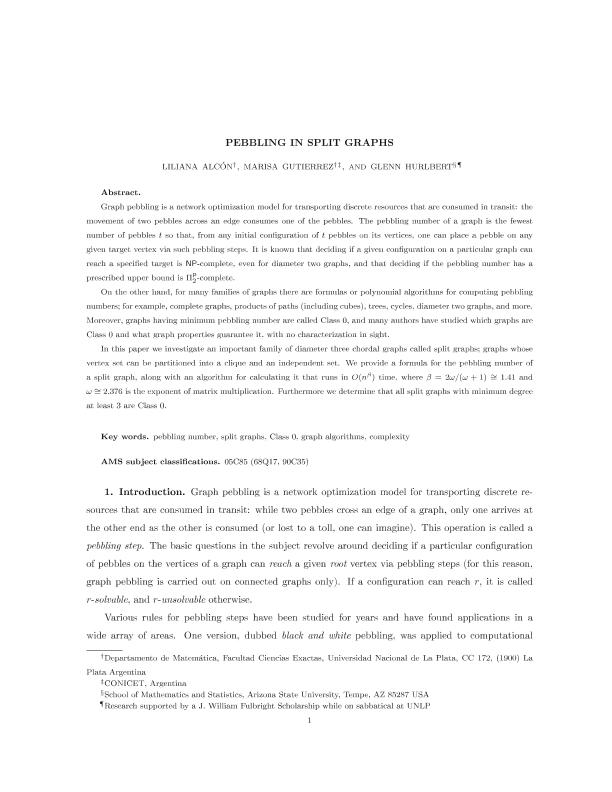Mostrar el registro sencillo del ítem
dc.contributor.author
Alcón, Liliana Graciela

dc.contributor.author
Gutierrez, Marisa

dc.contributor.author
Hurlbert, Glenn
dc.date.available
2018-01-11T17:38:56Z
dc.date.issued
2014-08
dc.identifier.citation
Hurlbert, Glenn; Gutierrez, Marisa; Alcón, Liliana Graciela; Pebbling in Split Graphs; Society for Industrial and Applied Mathematics; Siam Journal On Discrete Mathematics; 28; 3; 8-2014; 1449-1466
dc.identifier.issn
0895-4801
dc.identifier.uri
http://hdl.handle.net/11336/32989
dc.description.abstract
Graph pebbling is a network optimization model for transporting discrete resourcesthat are consumed in transit: the movement of 2 pebbles across an edge consumes one of thepebbles. The pebbling number of a graph is the fewest number of pebblestso that, from anyinitial configuration oftpebbles on its vertices, one can place a pebble on any given target vertex viasuch pebbling steps. It is known that deciding whether a given configuration on a particular graphcan reach a specified target isNP-complete, even for diameter 2 graphs, and that deciding whetherthe pebbling number has a prescribed upper bound is ΠP2-complete. On the other hand, for manyfamilies of graphs there are formulas or polynomial algorithms for computing pebbling numbers; forexample, complete graphs, products of paths (including cubes), trees, cycles, diameter 2 graphs, andmore. Moreover, graphs having minimum pebbling number are called Class 0, and many authors havestudied which graphs are Class 0 and what graph properties guarantee it, with no characterizationin sight. In this paper we investigate an important family of diameter 3 chordal graphs called splitgraphs; graphs whose vertex set can be partitioned into a clique and an independent set. We provide aformula for the pebbling number of a split graph, along with an algorithm for calculating it that runsinO(nβ) time, whereβ=2ω/(ω+1)∼=1.41 andω∼=2.376 is the exponent of matrix multiplication.Furthermore we determine that all split graphs with minimum degree at least 3 are Class 0.
dc.format
application/pdf
dc.language.iso
eng
dc.publisher
Society for Industrial and Applied Mathematics

dc.rights
info:eu-repo/semantics/openAccess
dc.rights.uri
https://creativecommons.org/licenses/by-nc-sa/2.5/ar/
dc.subject
Pebbling Number
dc.subject
Split Graphs
dc.subject
Class 0
dc.subject
Graph Algorithms
dc.subject
Complexity
dc.subject.classification
Matemática Pura

dc.subject.classification
Matemáticas

dc.subject.classification
CIENCIAS NATURALES Y EXACTAS

dc.title
Pebbling in Split Graphs
dc.type
info:eu-repo/semantics/article
dc.type
info:ar-repo/semantics/artículo
dc.type
info:eu-repo/semantics/publishedVersion
dc.date.updated
2018-01-10T20:29:18Z
dc.journal.volume
28
dc.journal.number
3
dc.journal.pagination
1449-1466
dc.journal.pais
Estados Unidos

dc.journal.ciudad
Philadelphia
dc.description.fil
Fil: Alcón, Liliana Graciela. Consejo Nacional de Investigaciones Científicas y Técnicas; Argentina. Universidad Nacional de La Plata. Facultad de Ciencias Exactas. Departamento de Matemáticas; Argentina
dc.description.fil
Fil: Gutierrez, Marisa. Consejo Nacional de Investigaciones Científicas y Técnicas; Argentina. Universidad Nacional de La Plata. Facultad de Ciencias Exactas. Departamento de Matemáticas; Argentina
dc.description.fil
Fil: Hurlbert, Glenn. Arizona State University; Estados Unidos
dc.journal.title
Siam Journal On Discrete Mathematics

dc.relation.alternativeid
info:eu-repo/semantics/altIdentifier/doi/http://dx.doi.org/10.1137/130914607
dc.relation.alternativeid
info:eu-repo/semantics/altIdentifier/url/http://epubs.siam.org/doi/10.1137/130914607
Archivos asociados
